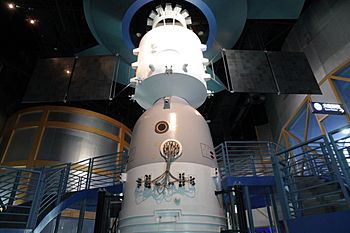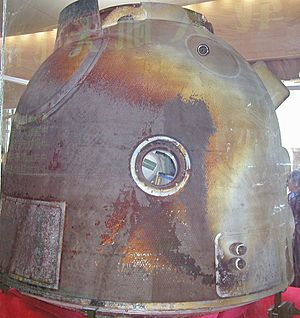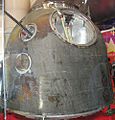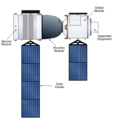Shenzhou 5 facts for kids

Mock-up of Shenzhou 5 Spacecraft
|
|
| Operator | |
|---|---|
| Mission duration | 21 hours, 22 minutes, 45 seconds |
| Orbits completed | 14 |
| Spacecraft properties | |
| Spacecraft type | Shenzhou |
| Launch mass | 7,790 kilograms (17,170 lb) |
| Crew | |
| Crew size | 1 |
| Members | |
| Start of mission | |
| Launch date | 15 October 2003, 01:00:03 UTC |
| Rocket | Long March 2F |
| Launch site | Jiuquan SLS-1 |
| End of mission | |
| Landing date | 15 October 2003, 22:22:48 UTC |
| Orbital parameters | |
| Reference system | Geocentric |
| Regime | Low Earth |
| Perigee | 332 kilometers (206 mi) |
| Apogee | 336 kilometers (209 mi) |
| Inclination | 42.4 degrees |
| Period | 91.2 minutes |
|
Shenzhou missions
|
|
Shenzhou 5 (Chinese: 神舟五号; pinyin: shénzhōu wǔ hào) was China's first mission to send a person into space. It launched on October 15, 2003. The spacecraft, called Shenzhou, was carried into orbit by a Long March 2F rocket. Before this, China had sent four uncrewed Shenzhou missions into space since 1999. With Shenzhou 5, China became the third country in the world to independently launch a human into space. The other two countries were the Soviet Union (now Russia) and the United States.
Contents
Meet the Astronaut
| Position | Crew Member | |
|---|---|---|
| Commander | Yang Liwei Only spaceflight |
|
The only astronaut on the Shenzhou 5 mission was Yang Liwei. He was 38 years old at the time and a former fighter pilot. His journey made history for China.
Mission Details
Shenzhou 5 was a very important mission. Here are some key facts about its journey:
- Weight: The spacecraft weighed about 7,840 kilograms (17,280 pounds).
- Lowest Orbit Point (Perigee): It flew as low as 332 kilometers (206 miles) above Earth.
- Highest Orbit Point (Apogee): It reached as high as 336 kilometers (209 miles) above Earth.
- Orbit Angle (Inclination): The spacecraft orbited Earth at an angle of 42.4 degrees to the equator.
- Time per Orbit (Period): Each trip around Earth took about 91.2 minutes.
Journey into Space
Shenzhou 5 blasted off at 9:00 AM (China time) from the Jiuquan Satellite Launch Center. This launch base is located in the Gobi Desert in Gansu Province. Just ten minutes later, at 9:10 AM, the spacecraft entered orbit, flying 343 kilometers above Earth. Aboard was astronaut Yang Liwei.
This launch was a huge step for China. It showed the world that China could send a person into space all by itself. This achievement was the result of a space program that started way back in 1992. Neither the launch nor the landing was shown live on TV. However, news quickly appeared on Chinese Central Television after both events.
Orbiting Earth
The Shenzhou spacecraft circled Earth 14 times. The entire mission lasted about 21 hours. The spacecraft began its return to Earth's atmosphere at 6:04 AM (China time) on October 16, 2003. Its parachute opened perfectly, and the astronaut reported feeling well.
The landing happened at 6:28 AM, very close to the planned spot in Inner Mongolia. The part of the spacecraft that stayed in orbit continued to do automated experiments. It remained in space until March 16, 2004, and then fell back to Earth on May 30.
After Yang Liwei's safe return, Premier Wen Jiabao congratulated him. Yang emerged from the capsule about 15 minutes later and waved to the recovery team. The control center in Beijing officially declared China's first human space mission a success.
Yang's Space Experience
Yang Liwei shared some details about his time in space. He mentioned feeling "very uncomfortable" due to unusual vibrations. These vibrations happened about two minutes after the rocket launched. Because of this, engineers made changes to the design of the next Long March 2F rocket for the Shenzhou 6 mission.
Global Impact
The launch of Shenzhou 5 was a massive event in China. Newspapers and official media celebrated it as a great success for Chinese science and technology. It was also seen as a moment of national pride. Interestingly, Yang Liwei showed both the flag of China and the flag of the United Nations during his flight. Chinese media also reported that seeds from Taiwan were carried aboard the spacecraft.
President Hu Jintao spoke at a celebration for the mission. He called it "an honor for our great motherland." He also said it was "an historic step taken by the Chinese people" in reaching the top of world science and technology. President Hu thanked everyone who helped make the mission a success.
Leaders around the world also praised China's achievement. Prime Minister of Japan Junichiro Koizumi called it "a great feat." United States President George W. Bush congratulated President Hu and wished China continued success in space. A U.S. State Department spokesperson applauded China for becoming only the third country to launch people into space. NASA Administrator Sean O'Keefe called Shenzhou 5 an "important achievement in human exploration."
The Shenzhou 5 spacecraft has since been featured in many celebrations, both in China and other countries. For example, North Korea even made commemorative stamps showing the Chinese spacecraft.
Gallery
-
The space suit worn by Shenzhou 5 crew member Yang Liwei on display
Images for kids
See also
 In Spanish: Shenzhou 5 para niños
In Spanish: Shenzhou 5 para niños





